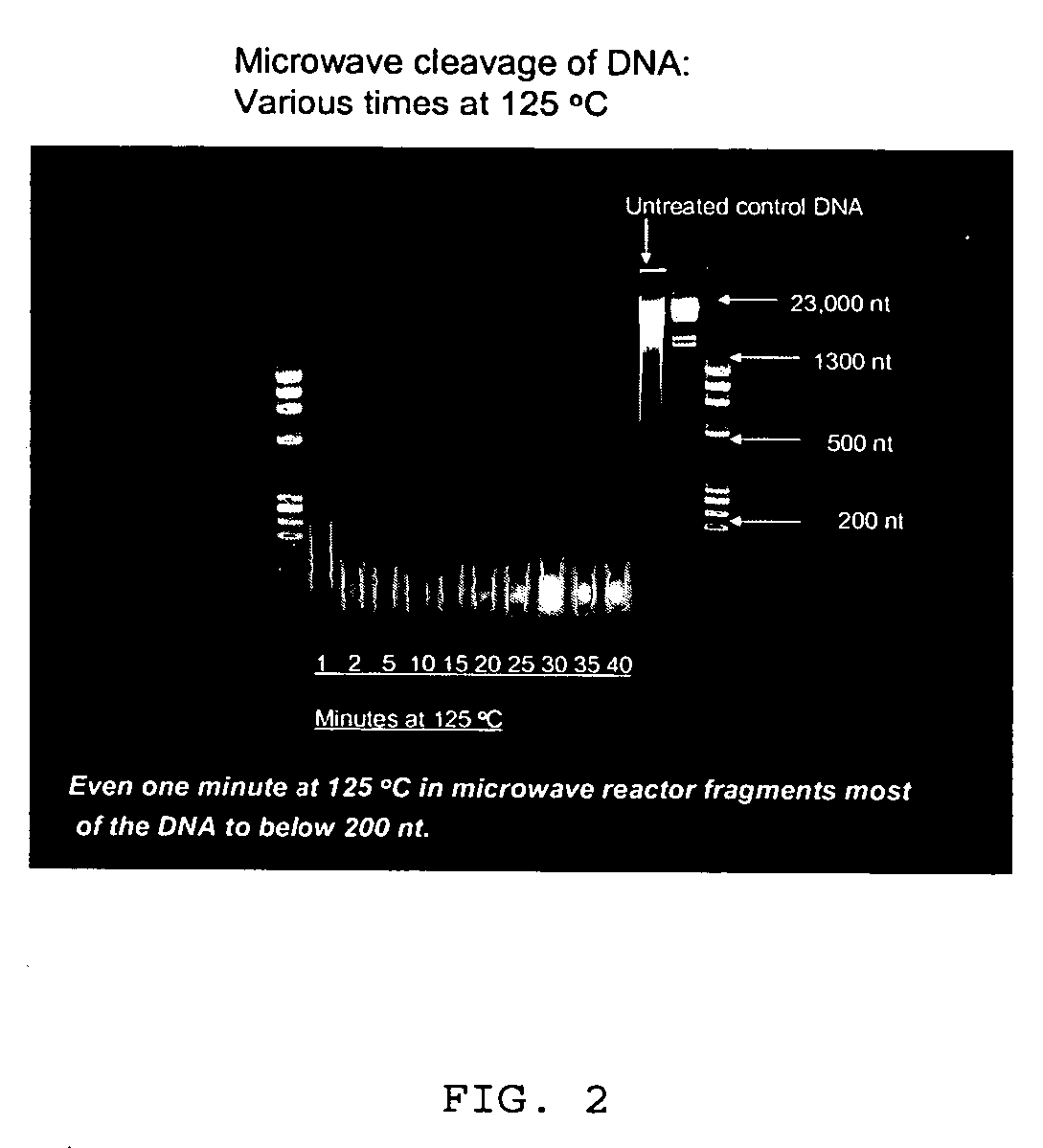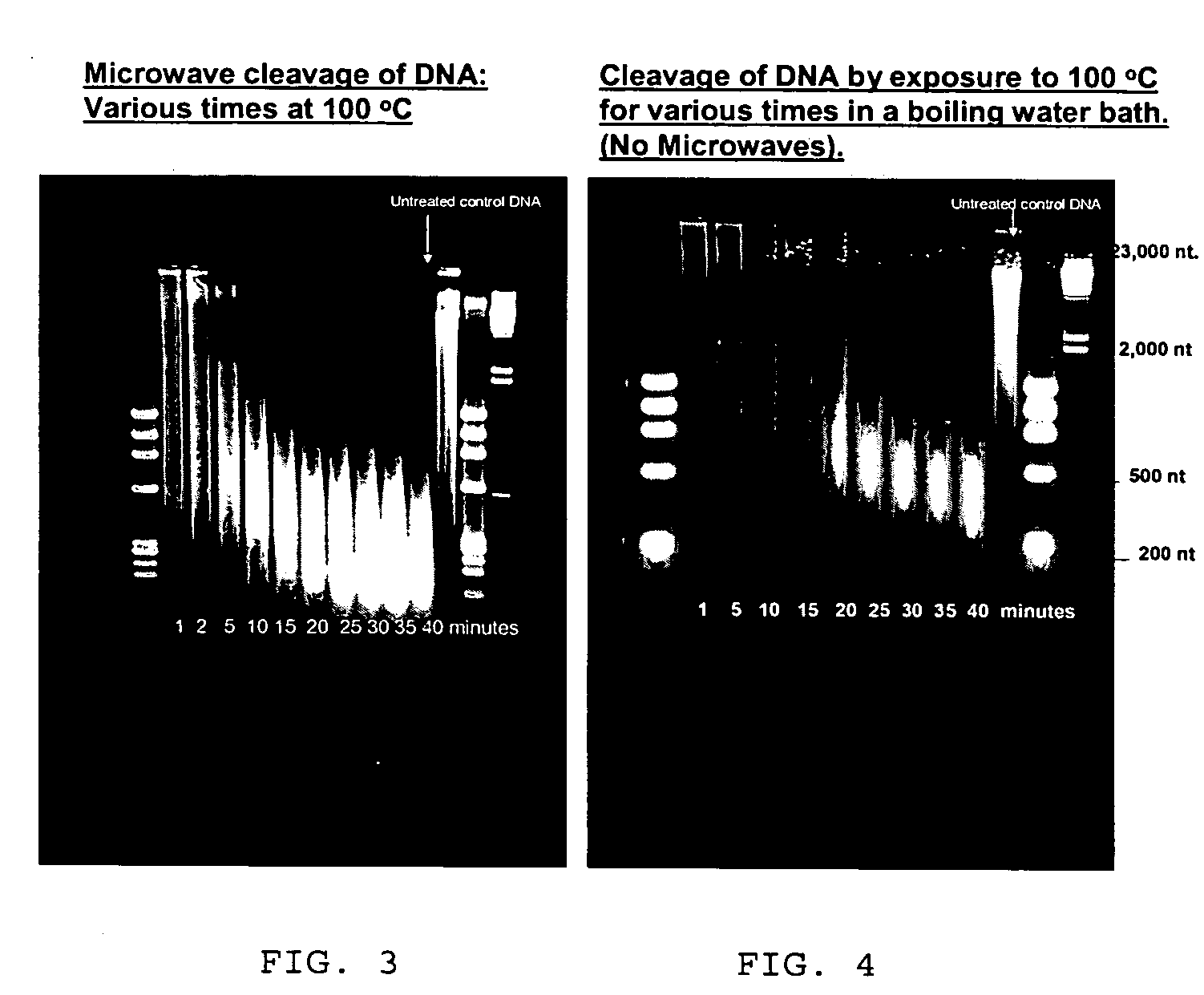Microwave mediated synthesis of nucleic acid probes
- Summary
- Abstract
- Description
- Claims
- Application Information
AI Technical Summary
Problems solved by technology
Method used
Image
Examples
example 1
Microwave-Assisted Synthesis of Hydrazine-Modified ssDNA
(a) Preparation of Transamidation Solution
[0094] In a 50 mL conical tube, sodium bisulfite (1.06 g, 10 mmoles), sodium phosphate, monobasic (1.38 g, 10 mmoles) and hydroquinone (110 mg, 1 mmole) were dissolved in approximately 5 mL deionized water. To this solution was added hydrazine hydrate (1.5 mL, 30 mmoles) under ice cooling to give a pH of 8.7. The pH was adjusted with concentrated hydrochloric acid to pH of 7.2. This solution was used immediately and the remainder discarded.
(b) Microwave-Assisted Hydrazinolysis of Herring Sperm ssDNA
[0095] The transamidation solution (500 μL) and ssDNA (20 μg) were microwaved in a heavy-wall glass tube (CEM Corporation, 908035) fitted with a stirbar and Teflon-lined silicone septum pressure cap, for one hour at 50° C. (50 W, 50 psi max, 30 s ramp) using a commercial microwave synthesizer (Discovery, CEM Corporation). The pH of the reaction solution was raised by addition of 200 μL ...
example 2
Microwave-Assisted Synthesis of fluorescein-5-thiocarbamo-DNA
[0097] In a heavy-wall glass tube (CEM Corporation, 908035), hydrazine-modified herring DNA (5 82 g in 100 μL EB buffer) was mixed with 200 μL 1 M CAPS, pH 10 and 300 μL fluorescein-5-isothiocyanate (FITC) (20 mg / mL DMSO). The solution was microwaved for 30 minutes at 50° C. (50 W, 50 psi max, 30 s ramp). The DNA was purified by capture on glass-fiber columns (QIAprep Spin Columns, 27106, Qiagen Corporation) according to manufacturer's directions. In short, the reaction solution was diluted with five volumes of binding buffer (PB) and passed through a QIAprep spin column using a vacuum manifold. The column was washed with 500 μL PB buffer, then with 10×500 μL PE (wash) buffer, or until no fluorescence was detected in the wash. The column was centrifuged for one minute at 13,000 g, discarding the residual PE buffer. The ssDNA was eluted with 100 μL EB buffer by centrifuging 13,000 g for one minute. The incorporation of flu...
example 3
Labeling by Bisulfate Transmission Using fluorescein hydrazide in a Microwave Reactor
[0100] A bisulfite solution was made by dissolving 1.56 g NaHSO3 and 0.64 g Na2SO3 in 4.3 ml of water. Hydroquinone, 200 ul of a fresh 50 mM solution, was added to yield the activation solution.
[0101] 300 ul of the activation solution was added to 100 ul of ssDNA (50 ug total) solution in water containing 10 mg / ml Fluorescein hydrazide (1 mg total) in a microwave reactor tube which was then sealed. (Stock DNA is fragmented herring DNA at a concentration of 10 mg / ml in water, denatured by immersing in boiling water bath for 10 minutes followed by freezing in a dry ice ethanol bath and stored at minus 80° C.) The sealed reactor tube was placed in the microwave reactor which was then run at 80° C. for 10 min.
[0102] After cooling the DNA was diluted by adding 5 volumes of Qiagen solution PB and purified on a Qiagen spin column. Five washes with PB were followed by 5 washes with Qiagen solution PE and...
PUM
| Property | Measurement | Unit |
|---|---|---|
| Electrophilic | aaaaa | aaaaa |
Abstract
Description
Claims
Application Information
 Login to View More
Login to View More - R&D
- Intellectual Property
- Life Sciences
- Materials
- Tech Scout
- Unparalleled Data Quality
- Higher Quality Content
- 60% Fewer Hallucinations
Browse by: Latest US Patents, China's latest patents, Technical Efficacy Thesaurus, Application Domain, Technology Topic, Popular Technical Reports.
© 2025 PatSnap. All rights reserved.Legal|Privacy policy|Modern Slavery Act Transparency Statement|Sitemap|About US| Contact US: help@patsnap.com



